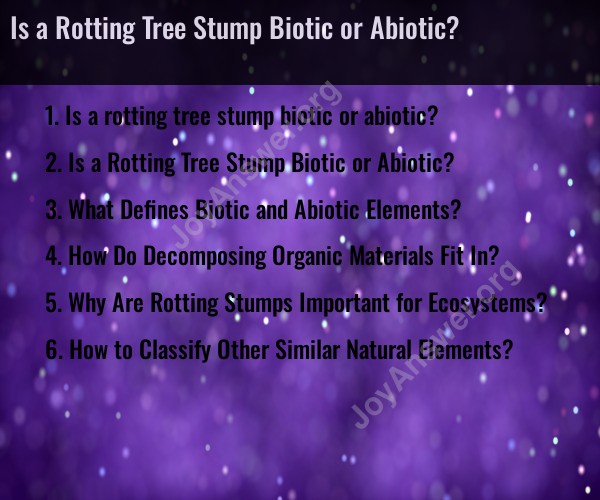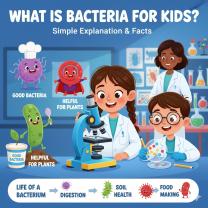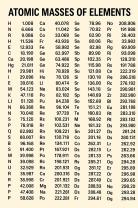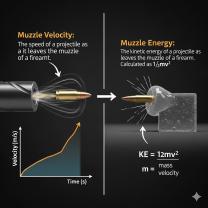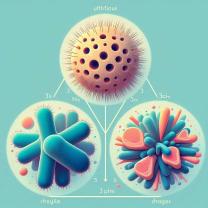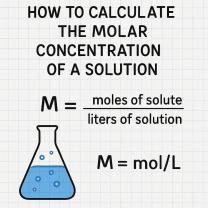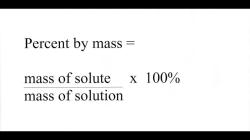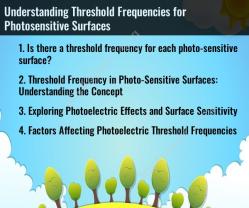Is a rotting tree stump biotic or abiotic?
A rotting tree stump is considered biotic, because it comes from a living organism (the tree) and still contains living things—such as fungi, bacteria, and insects—that are breaking it down.
Even though the tree itself is dead, the stump remains part of the biotic component of an ecosystem, since it originated from life and continues to interact with other living organisms during decomposition.
Rotting Tree Stumps: A Closer Look at Their Role in Ecosystems
The classification of a rotting tree stump as biotic or abiotic is a fascinating question that reveals the complex and interconnected nature of ecosystems. While the stump was once part of a living tree, its current state and function are more nuanced.
Is a Rotting Tree Stump Biotic or Abiotic?
A rotting tree stump is best described as a transitional element that contains both biotic and abiotic components. The stump itself is abiotic in that it is no longer a living organism. However, it is teeming with biotic life. Fungi, bacteria, insects, and other decomposers are actively breaking it down, making the stump a vibrant habitat for a new community of organisms. So, while the stump's physical structure is dead organic matter (abiotic), the processes and organisms within it are very much alive (biotic).
What Defines Biotic and Abiotic Elements?
Biotic elements are all the living or once-living components of an ecosystem. This includes plants, animals, fungi, and microorganisms. Their defining characteristic is that they are organisms that perform life functions such as growth, reproduction, and metabolism.
Abiotic elements are the non-living physical and chemical components of an ecosystem. This includes things like sunlight, water, soil, temperature, air, and rocks. These elements are not alive, but they are essential for supporting life.
How Do Decomposing Organic Materials Fit In?
Decomposing organic materials, like a rotting tree stump, occupy a unique space. They are the bridge between the biotic and abiotic worlds. The stump itself is the abiotic material left by a once-living tree. The process of decomposition is carried out by biotic organisms (decomposers) that break down this organic matter. This process releases vital nutrients back into the soil, which are then used by new plants (biotic). Therefore, a decomposing stump is a site of intense biological activity that transforms dead organic matter into the raw, non-living materials needed to sustain new life.
Why Are Rotting Stumps Important for Ecosystems?
Rotting stumps are far from useless; they are incredibly important for a healthy ecosystem. They provide:
Nutrient Cycling: Decomposers in the stump break down the wood, returning essential nutrients like carbon and nitrogen to the soil. This enriches the ground and supports the growth of new plants.
Habitat and Shelter: The stump provides a home and shelter for a wide variety of organisms, including insects, small mammals, reptiles, and amphibians.
Soil Formation: As the stump breaks down, it contributes to the formation of new soil, improving its structure and fertility.
Biodiversity: By supporting a diverse community of decomposers, fungi, and insects, rotting stumps increase the overall biodiversity of an ecosystem.
How to Classify Other Similar Natural Elements?
When classifying other similar natural elements, a good rule of thumb is to consider their current state and function.
A fallen log: Similar to a stump, a fallen log is an abiotic structure that becomes a habitat for biotic organisms.
A skeleton: A skeleton is the abiotic remains of a once-living animal, serving as a source of nutrients for decomposers.
A fossil: A fossil is a unique case where the organic material has been completely replaced by minerals. It is entirely abiotic, but it is a record of a once-living organism.
Humus (rich soil): Humus is mostly composed of decomposed organic matter, making it an abiotic component of the soil. However, it is teeming with living microorganisms, making it a critical hub for biotic activity.
In all these cases, the distinction is often a matter of context: is the element the non-living material itself, or is it the vibrant community of life it supports?
